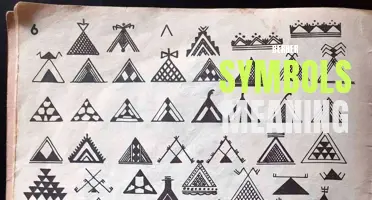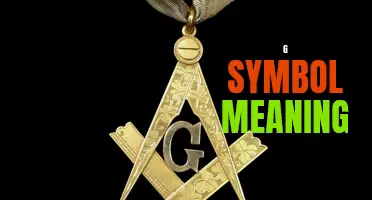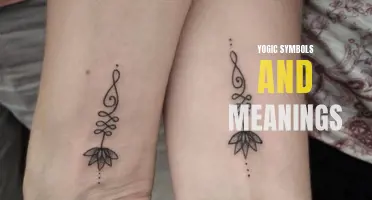
The Polynesian culture is rich in symbolism, with various symbols having deep meanings that have been passed down through generations. These symbols reflect Polynesians' deep connection with nature, spirituality, and their close-knit communities. From Maori tattoos to Tongan tapa designs, Polynesian symbols are fascinating and hold narratives of the Pacific Island's history, legends, and values. Understanding the meanings behind these symbols can provide a captivating glimpse into the profound beliefs and traditions of the Polynesian people.
What You'll Learn
- What are some common Polynesian symbol meanings?
- How do Polynesian symbols differ from symbols in other cultures?
- Are there certain Polynesian symbols that are considered more sacred or powerful?
- Can you provide examples of Polynesian symbols and their meanings?
- How have Polynesian symbol meanings evolved over time?

What are some common Polynesian symbol meanings?
Polynesian culture is rich with symbolism, and many symbols hold significant meanings. These symbols are often found in Polynesian art, tattoos, and even everyday objects. Here are some common Polynesian symbol meanings:
- Tiki: The Tiki symbol represents the first man in Maori mythology and is often depicted as a human figure with large eyes, open mouths, and a sharp nose. It symbolizes fertility, protection, and the connection between humans and gods.
- Marquesan Cross: Also known as the cross of four chiefs, the Marquesan Cross is an intricate design that symbolizes balance, harmony, and protection. It represents the four elements: earth, air, fire, and water.
- Turtle: In Polynesian culture, the turtle symbolizes longevity, peace, and navigation. It is often associated with the sea and voyages, as turtles are known for their ability to travel long distances.
- Manaia: The manaia is a mythical creature in Polynesian mythology that is believed to protect people from evil spirits. It is often depicted as a bird-like figure with a human head and symbolizes spirituality and guardianship.
- Spearhead: The spearhead symbolizes strength, courage, and resilience. It is often associated with warriors and represents the ability to face challenges and overcome adversity.
- Enata: Enata symbols are humanoid figures typically used to represent ancestors, gods, or heroes. They can be depicted in various positions, such as standing or sitting, and often symbolize protection and guidance.
- Sun: The sun symbolizes life, light, and warmth. It represents energy, power, and vitality. In Polynesian culture, the sun is often associated with the gods and is a symbol of their eternal presence.
- Waves: Waves symbolize the ocean and the continuous flow of life. They represent change, adaptability, and the cyclical nature of life. Waves also symbolize the connection between humans and the sea.
- Hammerhead Shark: The hammerhead shark symbolizes strength, adaptability, and protection. It is often associated with strength in numbers and teamwork, as hammerhead sharks are known to travel in schools.
- Frangipani: The frangipani flower symbolizes beauty, femininity, and grace. It is often associated with love, purity, and sensuality. In Polynesian culture, the frangipani flower is commonly used in traditional ceremonies and celebrations.
These are just a few examples of the many symbols that hold significant meanings in Polynesian culture. Each symbol is deeply connected to the Polynesian way of life and carries a unique story and message. Whether in art, tattoos, or everyday objects, these symbols are a powerful representation of Polynesian heritage and traditions.
Decoding the Symbols and Meanings of Hanukkah: The Festival of Lights
You may want to see also

How do Polynesian symbols differ from symbols in other cultures?
Polynesian symbols have a rich and distinct history that sets them apart from symbols in other cultures. These symbols, commonly found in tattoos, carvings, and artwork, hold immense cultural, spiritual, and historical significance.
One of the key differences between Polynesian symbols and symbols in other cultures is their connection to nature. Polynesian cultures, which include the Maori, Samoan, and Hawaiian people, have a deep respect for the natural world and believe that everything in it is interconnected. This belief is reflected in the symbols they use, which often incorporate elements from nature such as waves, fish, turtles, and birds.
In addition to their association with nature, Polynesian symbols also hold significant spiritual meanings. Each symbol is believed to possess its own mana, or spiritual power, which can be transferred to the wearer or the object it is used on. These symbols are often used as talismans for protection, guidance, and strength. For example, the enata symbol, which resembles a stick figure, represents human figures and is associated with personal growth and protection.
Another distinctive feature of Polynesian symbols is their intricate and geometric designs. These symbols are often composed of bold, black lines and intricate patterns that are carefully arranged to create a visually stunning effect. These designs not only add aesthetic beauty but also convey important meanings and stories. For instance, a spiral motif may represent the journey of life or the connection between past, present, and future.
Furthermore, Polynesian symbols differ from symbols in other cultures in terms of their historical significance. Many Polynesian symbols have ancient origins and are deeply rooted in the history and traditions of their respective cultures. These symbols have been passed down through generations and carry the weight of their ancestors' wisdom and knowledge. They serve as a visual representation of the cultural heritage and identity of the Polynesian people.
In conclusion, Polynesian symbols are unique and special. They differ from symbols in other cultures due to their connection to nature, spiritual meanings, intricate designs, and historical significance. These symbols not only add beauty to the Polynesian art but also serve as a powerful means of communication, preserving their rich cultural heritage for generations to come.
The Symbolic Meaning Behind BTS: Decoding the Hidden Messages in their Iconic Logo
You may want to see also

Are there certain Polynesian symbols that are considered more sacred or powerful?
Polynesian culture is rich with symbolism, and many of these symbols hold great significance in their society. While it would be inaccurate to label certain symbols as universally more sacred or powerful than others, there are some symbols that are widely recognized and respected among Polynesian communities.
One such symbol is the tiki. Tiki statues are intricately carved figures representing gods, ancestors, or guardians. These statues are believed to possess spiritual energy and are often placed at the entrance of homes or other sacred spaces to protect against evil spirits and bring good luck. Tiki statues vary in design and expression, each holding its unique meaning and purpose.
Another symbol that holds great power in Polynesian culture is the Manaia. The Manaia is a mythical creature resembling a bird or a human figure with a bird's head. It is seen as a guardian spirit and is associated with protection, spirituality, and communication between the earthly and spirit realms. The Manaia symbol is commonly incorporated into tattoos, jewelry, and other decorative art forms.
The turtle, or honu, is another symbol regarded as sacred in Polynesian culture. The turtle is seen as a representation of longevity, wisdom, and protection. In addition, turtles are believed to possess the knowledge of navigating through life's challenges. The honu symbol can often be found in Polynesian tattoos and artwork, usually depicted swimming gracefully in the ocean.
The koru is a spiral-shaped symbol that holds deep cultural significance in Maori culture, which is a Polynesian culture in New Zealand. It represents new beginnings, growth, and regeneration. The koru is often seen as the unfurling fern frond and is associated with the cycle of life. This symbol is commonly used in Maori art, including tattoos, carvings, and jewelry.
It is essential to remember that while these symbols hold cultural significance and are considered powerful and sacred within Polynesian culture, their true value lies in the beliefs and rituals associated with them. Each symbol carries its unique meaning and interpretation among different Polynesian communities. It is important to approach these symbols with respect and understanding, recognizing that their power lies in the collective cultural heritage and belief systems to which they belong.
Decoding the Mystical Meaning of the Metatron Symbol
You may want to see also

Can you provide examples of Polynesian symbols and their meanings?
Polynesian culture is rich with the use of symbols, which play important roles in various aspects of their lives. These symbols can be found in art, tattoos, and everyday objects, each carrying a significant meaning. Here are some examples of Polynesian symbols and their meanings:
- Tiki: The Tiki symbol represents the first man or the connection between humans and gods. It is characterized by a face with large eyes, a flat nose, and a prominent chin. Tiki is considered a guardian, and its image is often used for protection against evil spirits. It also symbolizes fertility, strength, and prosperity.
- Turtle: The turtle is a popular symbol in Polynesian culture, representing longevity, peace, and wisdom. It is often depicted as a sea turtle with intricately designed patterns on its shell. The turtle's ability to navigate through the vast ocean is seen as a metaphor for life's journey.
- Shark teeth: The shark teeth symbol, also known as niho mano, is associated with power and protection. The sharp teeth of the shark represent strength and the ability to overcome obstacles. It is commonly used in tattoos and worn as jewelry, serving as a reminder of one's inner strength.
- Spearhead: The spearhead symbol, known as the matau, represents bravery and determination. It is often depicted as a triangular shape with intricate designs. The spearhead symbolizes the warrior spirit and is commonly used in tribal tattoos. It is also believed to bring good luck and protect against harm.
- Sun: The sun symbol holds significant meaning in Polynesian culture, representing life, power, and leadership. It is often depicted as a circle with rays emanating from it. The sun symbolizes warmth, energy, and positive attributes. It is believed to bring light and guidance to one's path.
- Manaia: The manaia symbol represents a spiritual guardian or a guardian angel. It is depicted as a figure with a bird's head, a human body, and a fish tail. The manaia is believed to protect against evil spirits and bring good fortune. It is seen as a bridge between the material and spiritual worlds.
- Fish: Fish symbols are prevalent in Polynesian culture, representing abundance, fertility, and prosperity. They are often depicted with intricate designs, symbolizing adaptability and resilience. Fish also hold cultural significance in terms of sustenance and the connection to the sea.
It is important to note that the meanings of Polynesian symbols can vary slightly across different island nations and even between tribes within the same region. However, these symbols generally carry similar themes of spirituality, strength, protection, and connection to nature. They serve as a visual language to express cultural identity and beliefs, and are deeply rooted in Polynesian heritage.
Decoding the Meaning Behind LG Call Log Symbols: What Do They Really Stand For?
You may want to see also

How have Polynesian symbol meanings evolved over time?
Polynesian symbol meanings hold significant cultural and spiritual importance to the Polynesian people. These symbols have been passed down through generations and have evolved over time, adapting to the changing beliefs, customs, and practices of the Polynesian people.
Polynesian culture is rich in symbolism, and many of these symbols are found in their traditional art, tattoo, and other forms of expression. These symbols, often referred to as "kakau" in Hawaiian culture, "puamatangi" in Tahitian culture, and "tatatau" in Samoan culture, bear deep cultural and spiritual meanings.
One prominent Polynesian symbol is the "tiki." The tiki symbol represents a human-like figure with large, round eyes, a flat nose, and a wide mouth. It is believed to be the first man or god in Polynesian mythology and is associated with protection, fertility, and good luck. The tiki symbol has evolved over time to also represent ancestors and tribal spirits. Today, it is often seen in Polynesian art, jewelry, and tattoos as a symbol of Polynesian identity and pride.
Another important Polynesian symbol is the "Manaia." The Manaia symbol is a creature with the head of a bird, the body of a man, and the tail of a fish. It is believed to be a guardian spirit that protects the wearer from evil and brings good fortune. The Manaia symbol has evolved to also represent spiritual connections, ancestral guidance, and personal growth. It is often seen in Polynesian art, carvings, and tattoos as a symbol of protection and spirituality.
The "Marquesan cross" is another Polynesian symbol that has evolved over time. This symbol consists of four arms that form a cross, with intricate patterns and designs. In ancient times, it represented the four cardinal points and the balance between the elements of nature. Today, it has come to symbolize harmony, unity, and balance in life. The Marquesan cross is a popular symbol in Polynesian tattoos and is often personalized with additional symbols and designs.
The meanings of Polynesian symbols vary from island to island and from tribe to tribe. However, certain symbols hold common meanings across Polynesian cultures. For example, the "wave" symbol represents the ocean, life's challenges, and the journey of life. The "shark tooth" symbol represents protection and strength. The "turtle" symbol represents fertility, longevity, and wisdom.
As Polynesian culture has evolved and interacted with other cultures, the meanings and usage of Polynesian symbols have also changed. Today, Polynesian symbols can be found in various forms of art, jewelry, clothing, and even popular culture. They are no longer limited to traditional practices but have become a way for Polynesian people to represent and express their cultural heritage in a modern context.
In conclusion, Polynesian symbol meanings have evolved over time to adapt to the changing beliefs, customs, and practices of the Polynesian people. These symbols hold deep cultural and spiritual significance and are an important part of Polynesian identity and pride. As Polynesian culture continues to evolve and thrive, so too will the meanings and usage of Polynesian symbols.
Understanding Calculus Symbols: Interpreting the Meanings Behind the Mathematical Notations
You may want to see also
Frequently asked questions
In Polynesian culture, the turtle symbolizes longevity, peace, and wisdom. It is seen as a sacred creature that represents protection and good luck. On the other hand, the shark symbolizes strength, power, and adaptability. It is often associated with bravery and fearlessness, as well as the ability to navigate through the challenges of life.
The sun is a powerful symbol in Polynesian culture, representing life, light, and energy. It is often associated with positivity, growth, and new beginnings. The sun is seen as a source of power and vitality, and its rays are believed to bring blessings and protection. On the other hand, waves symbolize the ocean and its important role in Polynesian life. They represent the ebb and flow of life, as well as resilience and adaptability. Waves are also associated with the journey of life, as they can be both calm and peaceful, or powerful and challenging.
Birds are significant symbols in Polynesian culture, representing freedom, spirituality, and communication with the divine. They are often seen as messengers between the earthly realm and the spiritual realm. Birds also symbolize protection and guidance, as they are believed to watch over and guide individuals on their life journey. Flowers, on the other hand, symbolize beauty, growth, and femininity. Different types of flowers may have specific meanings in Polynesian art, but overall they represent the vibrant and colorful nature of the islands. Flowers are often incorporated into tattoos and other forms of artwork to bring beauty and positivity.







